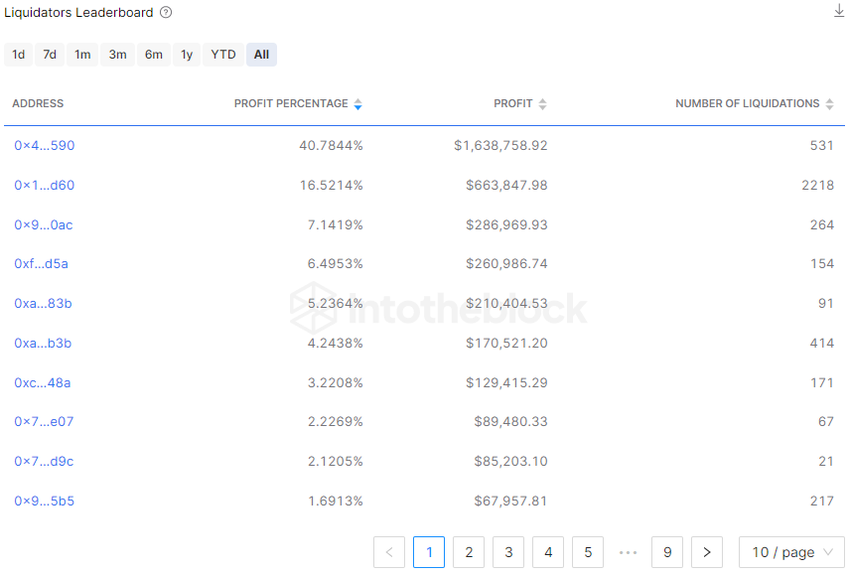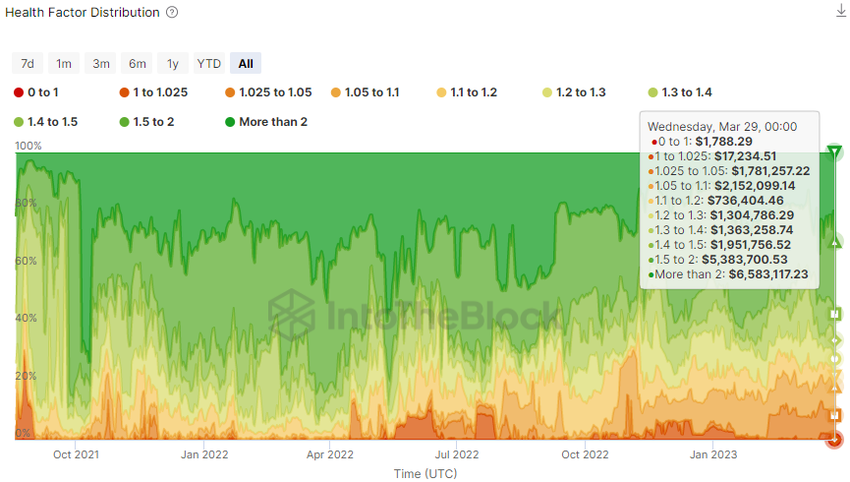DeFi lending protocols are decentralized finance (DeFi) platforms that allow users to borrow and lend cryptocurrencies without intermediaries such as banks. In these protocols, borrowers can use their cryptocurrency holdings as collateral to secure a loan. The collateral is held by the protocol and is released back to the borrower once the loan is repaid. On the other side, lenders can earn interest on their cryptocurrency holdings by lending them out to borrowers on the platform.
The considerable growth of the crypto industry has lured in hundreds of billions of dollars. However, as the industry has expanded, the number of scams and vulnerabilities has also increased. These risks are not yet fully understood at the individual and protocol levels. This article aims to provide clarity on the most significant economic risk vectors for DeFi’s lending protocols. We examine the major components of lending protocols and what factors users should consider in order to manage risk exposure.
BeInCrypto Trading Community in Telegram: read reviews on the best crypto platforms, get technical analysis on coins & answers to all your questions from PRO traders & experts!
Why is managing risk in DeFi important?

Effective monitoring and control of risks are crucial for any financial service. The recent incidents in the DeFi market have demonstrated that risk management is vital to stimulate the growth of the sector. Both users and protocols must prioritize risk management as a fundamental element for the success of the DeFi ecosystem.
Although technical issues have caused most attacks in DeFi, the economic risks have resulted in a higher monetary loss. All in all, economic risks can be intricate. However, such risk can be managed by observing indicators. These include shifts in liquidity within the protocols, participation from active liquidators, whale activity, and user leverage. Additionally, users have the ability to take steps to safeguard themselves from economic risks.
This piece uses indicators from IntoTheBlocks’s Risk Radar platform to showcase examples of active risk monitoring. The data shown in the indicators is from the Benqi protocol.
Liquidations indicators
Liquidations are important in DeFi protocols because they help maintain the lending platforms’ stability and well-being. In DeFi lending, borrowers typically use their cryptocurrency holdings as collateral for the loans they receive. If the value of the collateral falls below a certain threshold, the borrower’s position becomes undercollateralized.
To prevent default and bad debt on the protocol, DeFi lending protocols will liquidate undercollateralized positions. Protocols sell off the collateral on the open market to repay the loan. This process is usually done by independent liquidators operating within the ecosystem. Overall, this process helps to ensure that lenders’ deposits are secure and maintain the solvency of the platform.

The Liquidators Leaderboard indicator can help DeFi lending protocols in mitigating risk by providing information on the effectiveness and efficiency of its liquidators’ activity.
By examining the data presented in the leaderboard, the protocol can evaluate its liquidators’ performance and identify trends. These might include which liquidators are the most successful and which collateral types are most commonly involved in liquidations. This data can be used to make adjustments to the protocol’s liquidation process. This might take the form of incentivizing top-performing liquidators or adjusting the collateral requirements for certain assets.
Sponsored SponsoredBorrowing indicators
Borrowing activity is crucial for assessing the health and growth of a DeFi lending protocol. A high level of borrowing activity typically indicates a high demand for credit. This can be a positive sign for the protocol’s growth. Additionally, monitoring borrowing activity can help the protocol manage risk, as it allows the protocol to identify potential issues, such as an over-reliance on a single asset or borrower. By tracking borrowing activity, the protocol can adjust its lending policies and collateral requirements to manage its exposure to risk. Thereby maintaining the solvency of the platform.
Health Factor Distribution Indicator
The Health Factor Distribution indicator tracks how close a position is to liquidation. If the health factor is below 1, it can be liquidated, resulting in a loss to the borrower. The Health Factor Distribution indicator shows the share of borrowers within a particular range of health factors, excluding recursive loans. This indicator is useful for analyzing the different ranges of the protocol’s borrowers. If most of the supply has a low health factor, the solvency of the pool/protocol is at risk due to big liquidations.

The indicator provides valuable insights for both depositors and liquidators. As the number of loans at risk of liquidation increases, it becomes riskier for depositors to invest in the protocol. On the other hand, liquidators can use this information to their advantage. This is especially the case during periods of market volatility, where the indicator can predict where significant liquidations are likely to occur.
In addition, a balanced distribution of health factors suggests that loans in the protocol are more evenly spread among borrowers. Thus, reducing the likelihood of all loans being liquidated at once. This indicates a decentralized and diverse lending portfolio, which is generally seen as a positive attribute for DeFi lending protocols.
A DeFi lending protocol with a high distribution of health factors is considered to be more secure for depositors since it lowers the probability of large-scale liquidations. Such massive liquidations can often be unprofitable for liquidators due to slippage on decentralized exchanges (DEXs). Therefore, a high distribution of health factors should provide depositors with more confidence in their positions within the protocol.
Lending indicators
The Net Liquidity Flows indicator monitors the inflows, outflows, and net flows of liquidity into the protocol. This indicator helps identify potential liquidity risk vectors that may prompt action among its issuers. For instance, a significant outflow of funds may imply users are withdrawing their funds due to concerns about the protocol’s safety, which may lead to a liquidity crisis. Conversely, a large inflow of funds may suggest user confidence in the protocol’s stability and security.
Sponsored
This metric provides valuable information that allows the protocol to identify potential liquidity risks that may trigger activities among its users. In response to any issues, the protocol can make necessary adjustments to its risk management strategies and take measures to protect itself from bad debt. For instance, it may consider increasing collateral requirements. Or, it might reduce loan-to-value ratios on its loans to minimize its exposure to risk.
Keeping track of whales
Keeping track of whales’ activity in lending protocols is important because these large players have the potential to impact the market significantly. Their actions can affect the supply and demand of assets within the protocol, leading to volatility and potential risks for other users. By monitoring whale activity, lending protocols can gain insight into potential market movements and adjust their risk management strategies accordingly.
This metric monitors large depositors’ lending, repayment, and liquidation activities in a DeFi lending protocol. It can be helpful to analyze high-volume trader strategies and the intentions behind them.

The indicator above offers insights into the borrowing patterns of the biggest users of the Benqi protocol, which can be useful in guarding against bad debt. By examining the data, the protocol and its users can detect any possible risks or weaknesses in its lending portfolio, such as over-reliance on a small group of users or excessive borrowing.
Leverage indicators
Recursive lending strategies are those which borrow an asset that is then resupplied into the lending side and potentially borrowed again. Thus, rehypothecating the protocol’s debt. This type of strategy has gained traction in the DeFi space to earn greater token rewards on a given asset. Nevertheless, it carries some risk as it requires constant monitoring of market conditions and fluctuations in interest rates to prevent liquidations.
Sponsored Sponsored
Understanding the proportion of recursive lending in a DeFi protocol can be beneficial in assessing the protocol’s stability and the potential for yield generation. The proportion of liquidity derived from recursive lending strategies can indicate how heavily a protocol relies on incentives to attract depositors.
A high percentage of recursive lending may imply that the liquidity is less stable and more prone to short-term farming of yield rather than being committed to the protocol for the long term.
Additionally, the proportion of liquidity supplied by recursive lending strategies can serve as an indicator of the level of yield generated within the DeFi protocol. This is valuable in assessing potential investment opportunities.
Understand lending protocols and be aware of the risks
DeFi is constantly evolving, and appropriate tools like the ones discussed in this article can help move the ecosytem in the right direction. While DeFi offers attractive yield opportunities, it also poses great risks. Keeping track of all these risks is essential, especially when depositing large amounts.
On the other hand, the industry is establishing best practices to mitigate technical and economic risks, such as opting for audits, using multi-sigs for deposit management, and improving oracles for price feeds. With the transparent tool insights provided by open-source crypto, the industry as a whole can strengthen and mitigate economic risks. Although risk will continue to exist, developers and users can better understand and take measures to mitigate them.
Frequently asked questions
What is recursive lending and why has it become a popular strategy in DeFi?
What are some potential risks associated with the recursive lending strategy?
Why is it important for DeFi protocols to monitor the borrowing behavior of their largest users?
What are some of the risks associated with investing in DeFi protocols, and how can they be mitigated?
About the author
Pedro Negron is currently a junior research analyst at IntoTheBlock, where he is directly involved with analysis of the most recent developments in crypto. He examines crypto from a data-centric perspective researching major sectors such as DeFi’s major protocols. Other areas of interest include Bitcoin and NFTs, which are analyzed from a data-driven standpoint.

